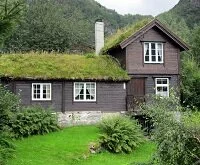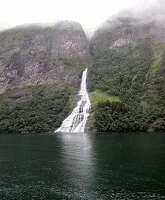History
The geological history of Geirangerfjord dates back millenia, however the fjord's settlement is a much more recent event. Having very steep mountain walls falling straight into the water, the region is not well suited for human settlement. Along the entire fjord there are only a couple places where the land is flat enough for people to call home. Among these, the most notable is the town of Geiranger, which sits at the end of the fjord. This town, like all others along the fjord, is very limited in size as the town cannot expand due to the mountains. Because of this all settlements on the fjord are small villages many of which are home to the ancestors of people who have called these towns home for centuries.
Geirangerfjord Today

House in Geiranger
The people who live along Geirgangerfjord live simple lives much as the people of Norway have lived for centuries (although now with numerous tourist amenities). These people continue to be reliant on the landscape as the waters provide both food and transportation and the mountains nearly isolate the people. Although cruise ships and tourists are now common in Geirangerfjord, this tourism is fairly seasonal so the people cling to their historic way of life for much of the year.
Natural Wonders
 Geirangerfjord: Not surprisingly the highlight of Geirangerfjord is the fjord itself. This deep fjord is among Norway's most impressive as it's perfect for kayaking, cruising, or spending time along the shore taking a hike or just sitting at a lookout and staring at the natural beauty of the mountains, waters, and numerous waterfalls.
Geirangerfjord: Not surprisingly the highlight of Geirangerfjord is the fjord itself. This deep fjord is among Norway's most impressive as it's perfect for kayaking, cruising, or spending time along the shore taking a hike or just sitting at a lookout and staring at the natural beauty of the mountains, waters, and numerous waterfalls.
 Bridal Veil Waterfall (Brudesløret): This waterfall, on the fjord's north side, is one of the many waterfalls that line the Geirangerfjord.
Bridal Veil Waterfall (Brudesløret): This waterfall, on the fjord's north side, is one of the many waterfalls that line the Geirangerfjord.

Suitor Waterfall
 Seven Sisters Waterfall (De syv søstrene): This waterfall is on the fjord's north side and is one of the many waterfalls that line the Geirangerfjord.
Seven Sisters Waterfall (De syv søstrene): This waterfall is on the fjord's north side and is one of the many waterfalls that line the Geirangerfjord.
 Suitor Waterfall (Friaren): This narrow waterfall is one of the many waterfalls that line the Geirangerfjord.
Suitor Waterfall (Friaren): This narrow waterfall is one of the many waterfalls that line the Geirangerfjord.
Scenic Drives & Viewpoints
 Dalsnibba: At the end of the Nibbevegen Road, this viewpoint offers excellent views of the fjord as well as the interior mountains, but you must have a car to make the journey and the road is only open from May to October.
Dalsnibba: At the end of the Nibbevegen Road, this viewpoint offers excellent views of the fjord as well as the interior mountains, but you must have a car to make the journey and the road is only open from May to October.
 Eagle Road (Ørnevegen): This road is perhaps the most daunting of the roads around Geiranger as it stretches to the home of the eagles. At the road's highest point, Ørnesvingen there is a center to stop and enjoy the scenery, which includes great views of the fjord and the Seven Sisters Waterfall.
Eagle Road (Ørnevegen): This road is perhaps the most daunting of the roads around Geiranger as it stretches to the home of the eagles. At the road's highest point, Ørnesvingen there is a center to stop and enjoy the scenery, which includes great views of the fjord and the Seven Sisters Waterfall.
 Flydalsjuvet: This is a great point to hike or drive to as it provides excellent views of the fjord below. There are a couple viewing platforms here and many cruise ships take passengers to this lookout so try to get here early or late in the day to avoid the crowds.
Flydalsjuvet: This is a great point to hike or drive to as it provides excellent views of the fjord below. There are a couple viewing platforms here and many cruise ships take passengers to this lookout so try to get here early or late in the day to avoid the crowds.